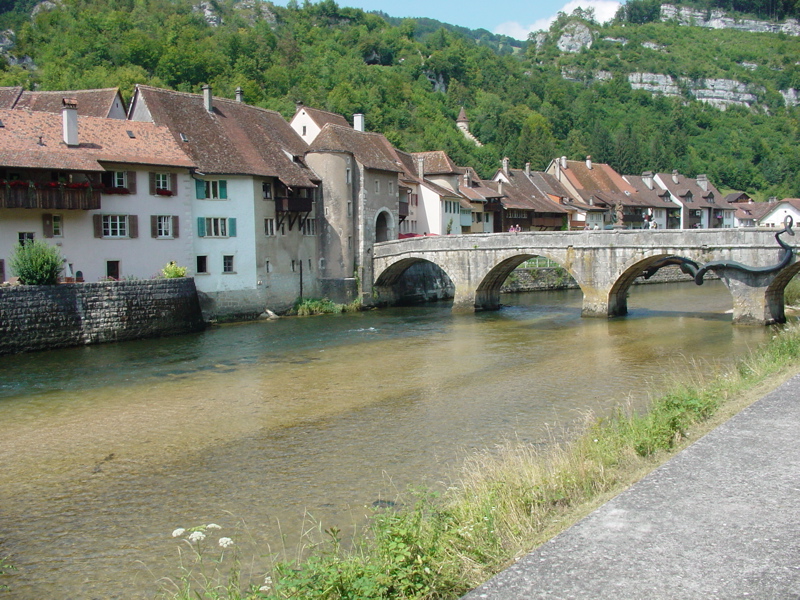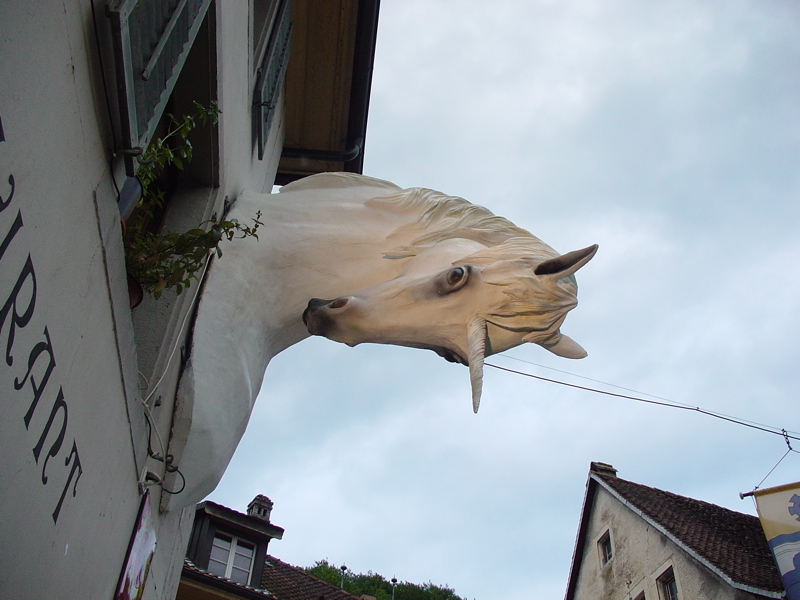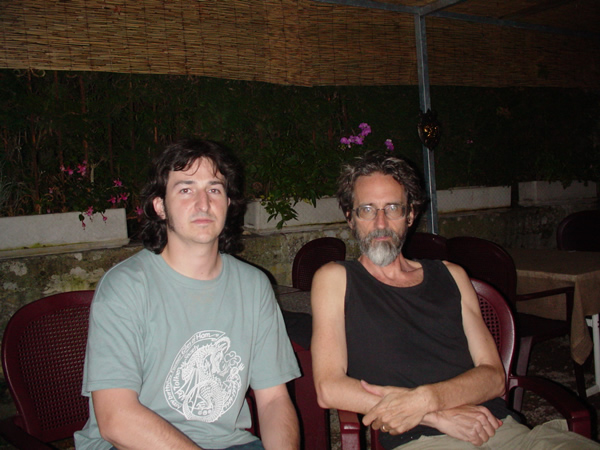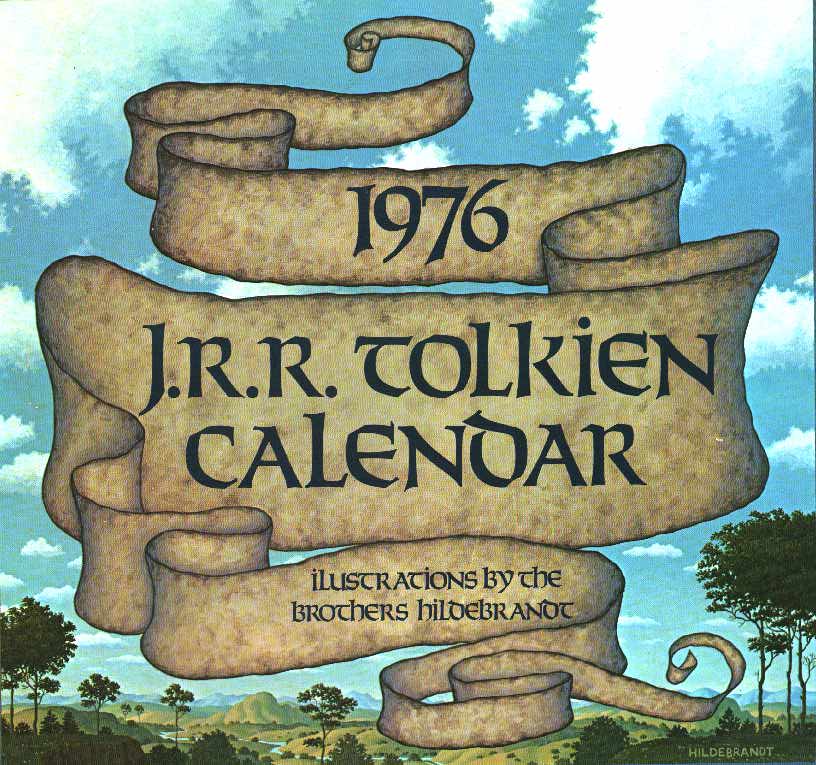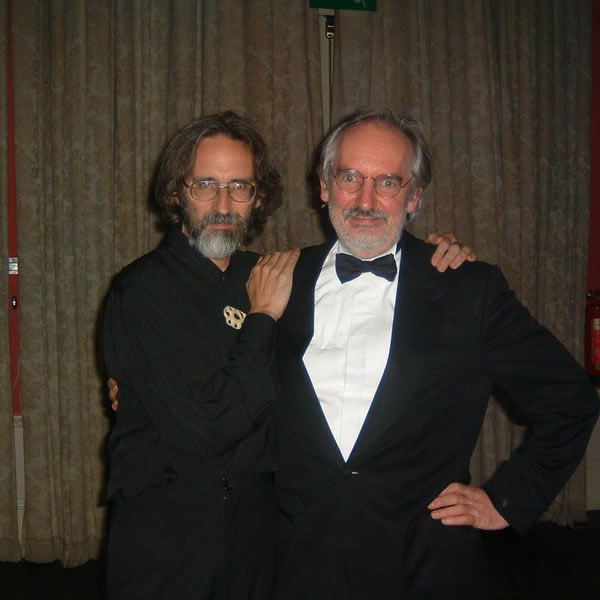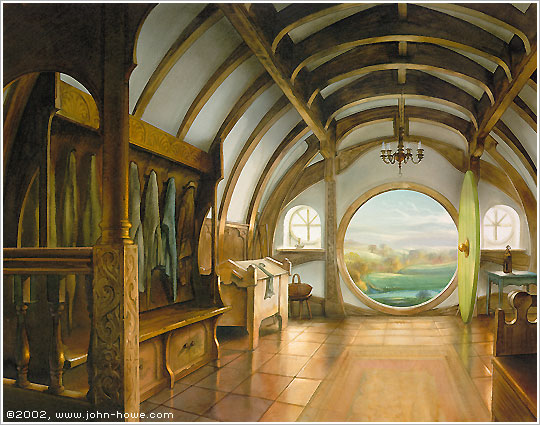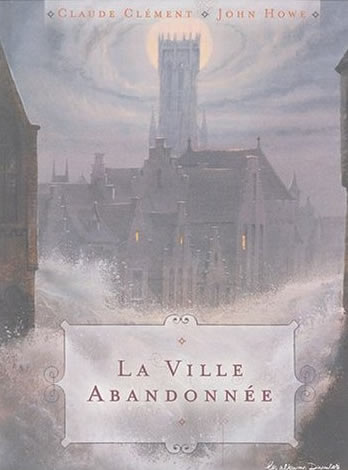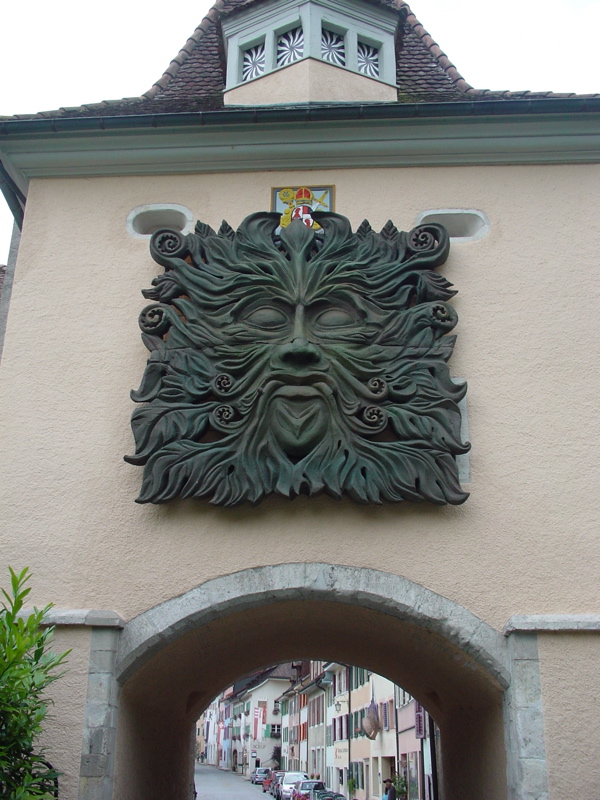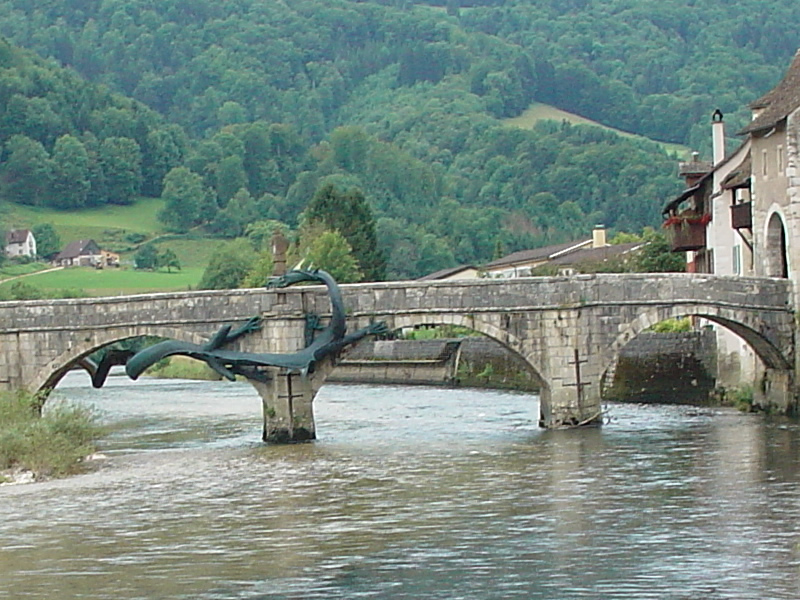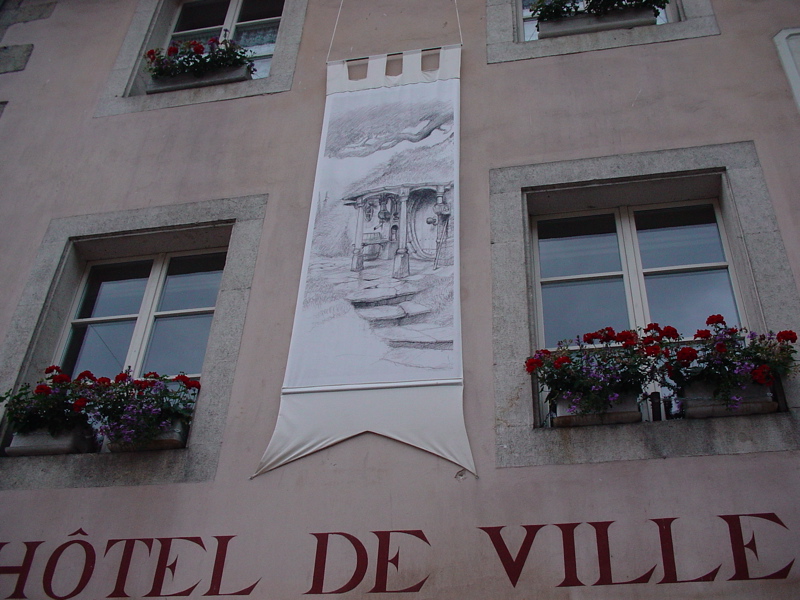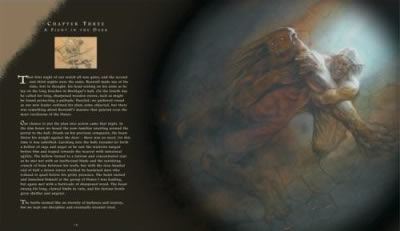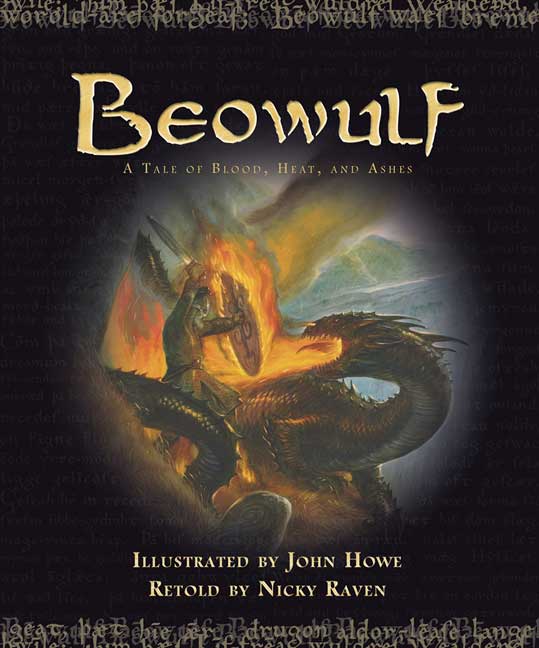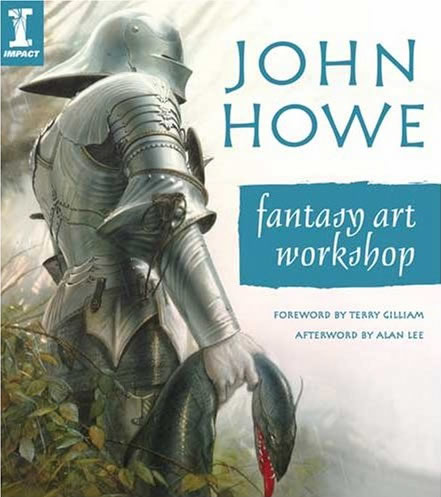Interview with John Howe in Saint-Ursanne, Switzerland (07.09.07 by Pieter Collier) - Comments
John Howe together with a team of Jurassian sculptors and specialists took by storm walls, façades and ancient squares in Saint Ursanne Town Centre.
In Saint-Ursanne you get submerged in a real “World of Fantasy” in the heart of a medieval town, day and night.
The creatures on exhibit in the Old Town were created and drawn by John Howe. Marc Grélat, art-metal-worker made the metall frames, and Michel Marchand, artist an head of the art studio, modelled them. They were aided by about ten people from the region of St. Ursanne.
John Howe on Art and Inspiration in Saint-Ursanne, Switzerland
Q: Did you have a great exposure to art when you were young?
Very little. Practically none, in fact. I actually only managed to take an art class in my first and last years of high school.
Q: And still you decided to study art?
Most English Canadians really wish to go to Europe at least once. My initial plan was to spend a year in France, go to some kind of school and learn a bit of French. I went a year in an American college in the outskirts of Strasbourg, but got a glimpse of a REAL art school, L’Ecole des Arts Décoratifs, and enrolled the following year. I initially moved to Switzerland for work on an animated feature film, and have been here ever since.
Q: How does it influence you to come to Europe being Canadian?
It is a VERY different world. I think I was interested in history without knowing it and that became very clear when I arrived in France. Everything that I was really interested in was there, but I knew nothing, no education, no art education, no education beyond high school. It was extremely overwhelming and it still is.
It is obvious if we lived in Canada we would have a bigger house and more cars, but you can’t have what you can find here. Information and inspiration are everywhere… history, art, architecture, everything an illustrator needs. Europe is, after all, the land that has generated most of the enduring myths and legends of Western culture.
Q: When did Tolkien come into the picture?
I read the Lord of the Rings when I was around twelve, and – this is a story I’ve told a million times – read volume two first, then three and finally volume one last. I was obliged to get them from the local library, and The Fellowship of the Ring was ALWAYS out. I’m sure people would borrow it, keep it a month, get bogged down and give up and eventually return it to the library. (The Two Towers and The Return of the King rarely left the shelves, this was before The Lord of the Rings gained the incredible popularity it now enjoys – and deserves.) I had to bide my time for months, and eventually got tired of waiting and read the trilogy backwards.
Q: You started to draw immediately?
Q: You also started with a calendar?
Yes, in 1987. I had three pictures in that year’s calendar.
I met the editor in London for an exhibition and a Christmas party and I think she had had a little too much to drink so she gave me a job. No I’m kidding. I had actually been sending in work for a few years, hoping to get a piece or two published. I’m still very grateful.
Q: Talking about your website, why do you have a website?
I have a website because it's an interesting tool, very – and quite unexpectedly – useful for my work. It’s become an archive and a fairly complete on-line portfolio, as well as offering an opportunity to write a little.
I enjoy the writing part very much, actually, and must be careful it doesn’t take up too much of my time. The forum is also a good deal of fun.
To tell you the truth, I wouldn’t even have a web site if not for the generous help of my webmaster Dominique Javet, who put it together and set it up (and does the occasional trouble-shooting) for me.
Q. Do you meet a lot with other Tolkien artists and illustrators?
Yes I met Ted Nasmith a couple of times, and of course worked with Alan Lee in New Zealand.
Q. How did you get involved with the Peter Jackson movies?
I got a phone call and went to New Zealand. It was not really a difficult decision. We talked about it, my wife, our son and I, and our son –brave little kid - was willing to give it a try and so away we went. It was quite a change for him – new language, new country, and on the other side of the world besides. Working for Peter Jackson was quite an experience. Movie work demands long hours and a high level of concentration, but there was a very positive atmosphere and we were all eager to do something good. Our pre-production sketching came very far in advance of the actual film, so there wasn’t yet the incredible pressure of several thousand people running on a tight schedule. We where treated very well.
Q. How was the working process?
Peter would give us a brief description of a sequence or a scene and then we would begin sketching ideas on paper. Peter would review this initial approach, say what he liked and then we would eventually do additional sketches. The next step was either rendering those sketches as architectural plans and elevations or building a small model. The next stage would be either the set or miniature. It was very much a back-and-forth process, a very stimulating framework to create in.
Q. You do not plan to make a book similar to Alan Lee's Lord of the Rings Sketchbook to show your sketches and art created for the movies?
Of course, but I don't have an editor for it. But I would enjoy that!
Alan’s project, The Lord of the Rings Sketchbook, was in the works before we worked in New Zealand, and the film work was included along the way. Of course, I would love to see the work published, there are hundreds of sketches that have never been published in any form.
Q. In the movies we can see a lot of images which are clearly illustrations that where originally created a lot of time before the movies. Did Peter Jackson ask to use these illustrations?
"Bag end" is a good example for this. Peter liked the illustration I had done for the Map of the Hobbit, and basically said "I love that view of the hall, so now can you just turn around and draw the rest of Bag End, please?"
Alan Lee's picture of Isengard is the same. Peter loved that image but it only showed the base of Orthanc, so Alan added sheet after sheet of paper one after the other, and worked his way to the top.
The Dark Tower was a similar case. The base of tower existed, but I had always been reluctant to actually draw the summit. I worked my way up quite slowly, not at all sure how the very top should look, which probably added a few hundred meters to the height of Barad-dûr.
Q. How did Saint-Ursanne La Fantastique come to be?
I had been to Saint-Ursanne and found the bridge very attractive, so naturally it ended up in the book.
Ursinia, the local cultural organisation, was searching for ideas for a summer festival or an exhibition and after stumbling on the picture with the bridge they got in touch.
We started out with the idea for a simple exhibition but Saint-Ursanne doesn’t have very much gallery space; the Caveau is quit small, and it’s not possible to put originals in the Cloister. Given those limitations, the idea of doing something more ambitious emerged – the dozen "installations" all around the town. It was a huge project for a town the size of Saint-Ursanne, especially for the sculptors, who did most of the work.
Q. And you are still working now, even while the event has started?
Unfortunately yes. We have one more statue to finish, a rhinoceros. It was announced in the program, so it is important to get it done.
Q. Saint-Ursanne will probably inspire other towns to call you?
But then again Saint-Ursanne is quite unique.
Part of the attraction lies in the fact that it is a temporary undertaking.
In September, everything will be gone, but I would enjoy having the opportunity to create something more permanent, but that’s a very different kind of project.
Q. How did you come up with the idea for a dragon on the bridge? Was it difficult to make?
Q. When you walk around in Saint-Ursanne you can see art on almost all the houses. The entire town was ready to participate?
Q. Did you decide about the films, the concerts, etc. ? Did you give advice?
I made a lot of suggestions, for example I suggested that they invite Vincent Ferré. He is just perfect for the literary conferences, and is France’s foremost Tolkien scholar.
I also suggested a number of groups for the different concerts.
Q. Was there one person directing everything?
There is a committee that makes all the important decisions. My responsibility is in the area of art direction, not running the festival itself.
Q. It must have been difficult to install all the statues and art?
Yes hanging things up on walls requires a team of specialists and heavy machinery. It can be quite dangerous. But amazingly enough I could find it all here in Saint-Ursanne. That is the astonishing part! The people who worked on the sculptures are all from Saint-Ursanne or the area. I think we had perhaps two visitors who came to work for a while. Locals did all work.
Q. What are you currently working on?
A new book for October 2008 and two books coming up this fall. One is a retelling of Beowulf and another is called Fantasy Art Workshop, about fantasy illustration.
Q. One final question I always was curious about. Is it difficult to get your illustrations published? Can you make suggestions for new books yourself?
I’ll have to answer yes and no. Occasionally projects just take off unexpectedly, sometimes you can work away at sketches and ideas for years before they are published. There re a number of authors I would be eager to illustrate.
And, of course, I would love to do some more Tolkien illustrations in the future, it’s a universe that one never tires of revisiting.
Spread the news about this J.R.R. Tolkien article:
